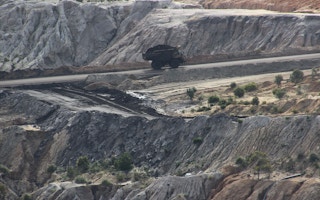The current debate in Australia about “clean” coal is akin to selling better quality cigarettes or, as it was put elegantly on the ABC’s Q&A recently, it is like selling “hot” ice. It’s an oxymoron. Clean coal simply doesn’t exist.
To continue reading, subscribe to Eco‑Business.
There's something for everyone. We offer a range of subscription plans.
- Access our stories and receive our Insights Weekly newsletter with the free EB Member plan.
- Unlock unlimited access to our content and archive with EB Circle.
- Publish your content with EB Premium.
We can use several techniques and technologies to ensure that the coal burns more efficiently and emits less air pollution, but it will never be clean. Burning dirt will always be dirty, by its very nature.
So then, what do people mean when they say clean coal? There are a number of definitions, but the one favoured by industry is quite general and includes any coal-fired power plant that features higher energy efficiency and emits less air pollution (such as soot, carbon dioxide, oxides of nitrogen and sulfur dioxide) than a typical coal-fired plant.
Central to the clean coal debate is the use of Carbon Capture and Storage (CCS) technology to capture these emissions, and bury them.
The Global CCS institute publishes a list of large-scale CCS facilities (both current and proposed) around the world. To be categorised by the institute as large-scale, CCS facilities must capture and inject sufficient quantities of CO2 into dedicated geological storage sites and/or enhanced oil recovery (CO2-EOR) operations.
The list shows that there are only two CCS projects for power generation in operation globally: the Boundary Dam project in Canada and the Petra Nova project in the US. A further 8 projects are currently in development (due for completion in the 2020’s). In total, these 10 projects promise to capture 15.3 million tonnes of carbon dioxide per year. That amounts to just 0.1 per cent of the 13,625 million tonnes emitted each year globally due to fossil fuel burning for electricity and heat production.
Billions of dollars have been spent to test, pilot and develop CCS technologies, but to date, these efforts have not had much success. This is because of a number of factors: complexities in the science, slow advances in technology, high cost and limited availability of adequate storage sites.
When you look at the cost of developing, building and running new “clean coal” plants, it is considerably higher than it is to produce the same amount of energy using renewables. As reported by Renew Economy, research by Bloomberg New Energy Finance (BNEF) puts the Levelised Cost of Electricity (LCOE) of a new ultra-supercritical coal-fired power station in Australia at A$134-203 per megawatt hour (MWh). This is significantly higher than the LCOE of new-build wind, which costs between A$61 and A$116/MWh.
Solar costs between A$A$78 and A$140/MWh, while combined-cycle gas power costs between A$74 and A$90/MWh; all are cheaper than coal power. And the cost of such coal plants plus CCS is significantly higher still, estimated by BNEF to have a LCOE in the ballpark of $A352/MWh – around three times the cost of wind or solar.
“
It is clear that developing countries do not see the adoption of 19th century technology to be the fastest, or even the cheapest, pathway to 21st century levels of development.
If not “clean” coal, how about “cleaner” coal?
Coal advocates often argue that Australian coal (specifically black coal) can have a higher calorific value (read: can be less CO2 intensive), burns cleaner than other coal and therefore can be used to replace dirtier coal in other countries and also help elevate people from energy poverty, in countries such as India.
This line of reasoning is often used to support the need for new coal mines in Australia, as is the case for the proposed Adani mine in north Queensland.
This argument is flawed.
The exported coal may not be burnt in Australia, but it will still be burnt. All that changes is the location of emissions. The ‘not in my backyard’ principle does not work in this case, or in any case for that matter.
Specifically with respect to the Adani proposal, India will continue to use cheaper Indian or Indonesian coal for the bulk of their generation with Australian coal primarily used as a blending fuel. This is not just due to the price but also due to a lack of robust air emission regulations.
Furthermore, India is looking to cut its dependence on fossil fuel imports. India has, since 2010, implemented a coal cess (coal tax) for all coal mined or imported into India. This coal tax started at around Rs 50 per tonne (about $A1 per tonne). Since then, it has multiplied eight-fold to the present level of ≈Rs 400 per tonne.
India also has a highly ambitious renewable energy target – 175GW of installed capacity by 2022. This would be 33 per cent of the country’s total installed capacity, and a three-fold increase in capacity from present levels. By 2027, India’s Draft National Electricity Plan forecasts that 43 per cent of its installed capacity will be renewables. The country expects that it will not need any new coal-fired power plants beyond 2017.
What this tells us is that Australian coal is not needed by the millions of Indians who don’t yet have access to electricity.
Also, a large proportion of these people live in regional towns and villages that are far more suited to de-centralized forms of energy such as solar rather than centralized coal-fired plants. Indeed, around the world in Africa, Latin America, parts of Asia, China and India, communities are already skipping coal based power in favour of cheaper, deployable and practical renewables.
It is clear that developing countries do not see the adoption of 19th century technology to be the fastest, or even the cheapest, pathway to 21st century levels of development.
In conclusion, Australia and the rest of the world will need to move away from fossil fuels to help us limit warming to 2 degrees, the earlier we start to transition to low carbon technologies and renewable sources the bigger the positive impact on our climate.
Neil Salisbury is co-founder and managing director, Point Advisory. This article was written exclusively for Eco-Business.











